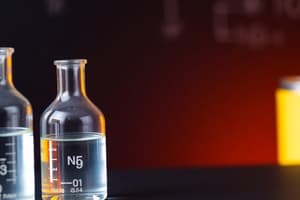Podcast
Questions and Answers
In a redox reaction, which statement is correct regarding oxidation and reduction?
In a redox reaction, which statement is correct regarding oxidation and reduction?
- Reduction involves losing electrons.
- Oxidation involves gaining electrons.
- Oxidation is associated with the loss of electrons. (correct)
- Reduction occurs without electron transfer.
What does the term 'limiting reactant' refer to in a chemical reaction?
What does the term 'limiting reactant' refer to in a chemical reaction?
- The reactant that produces the highest yield.
- The reactant that is present in excess.
- The reactant that does not participate in the reaction.
- The reactant that is completely consumed first. (correct)
Which of the following correctly describes the relationship between theoretical yield, actual yield, and percent yield?
Which of the following correctly describes the relationship between theoretical yield, actual yield, and percent yield?
- Percent yield is determined by (Actual Yield / Theoretical Yield) * 100%. (correct)
- Theoretical yield is the amount of product obtained in an experiment.
- Percent yield is calculated by Actual Yield + Theoretical Yield.
- Actual yield refers to the maximum potential product from a reaction.
In chemical reactions, how do equation interpretations differ from reaction mechanisms?
In chemical reactions, how do equation interpretations differ from reaction mechanisms?
How can understanding the type of a chemical reaction aid in predicting its outcome?
How can understanding the type of a chemical reaction aid in predicting its outcome?
What is the purpose of balancing a chemical equation?
What is the purpose of balancing a chemical equation?
Which of the following correctly describes a decomposition reaction?
Which of the following correctly describes a decomposition reaction?
What does the arrow (→) in a chemical equation signify?
What does the arrow (→) in a chemical equation signify?
In the reaction 2H₂ + O₂ → 2H₂O, what type of reaction is this?
In the reaction 2H₂ + O₂ → 2H₂O, what type of reaction is this?
Which statements are true regarding stoichiometry?
Which statements are true regarding stoichiometry?
What does the (aq) notation in a chemical equation indicate?
What does the (aq) notation in a chemical equation indicate?
What happens to the subscripts in a chemical formula during balancing?
What happens to the subscripts in a chemical formula during balancing?
Which of the following is an example of a combustion reaction?
Which of the following is an example of a combustion reaction?
Flashcards
Redox Reaction
Redox Reaction
A chemical reaction where electrons are transferred between reactants.
Limiting Reactant
Limiting Reactant
The reactant that is completely consumed first in a chemical reaction, limiting the amount of product formed.
Theoretical Yield
Theoretical Yield
The maximum amount of product that can be formed from a given amount of reactant, assuming complete reaction.
Actual Yield
Actual Yield
Signup and view all the flashcards
Chemical Equation
Chemical Equation
Signup and view all the flashcards
Reaction Mechanism
Reaction Mechanism
Signup and view all the flashcards
Reactants
Reactants
Signup and view all the flashcards
Products
Products
Signup and view all the flashcards
Balancing Chemical Equations
Balancing Chemical Equations
Signup and view all the flashcards
Synthesis (Combination) Reaction
Synthesis (Combination) Reaction
Signup and view all the flashcards
Decomposition Reaction
Decomposition Reaction
Signup and view all the flashcards
Single Replacement Reaction
Single Replacement Reaction
Signup and view all the flashcards
Double Replacement Reaction
Double Replacement Reaction
Signup and view all the flashcards
Study Notes
Chemical Equations
- A chemical equation represents a chemical reaction using symbols and formulas of the reactants and products.
- Reactants are the substances that undergo a chemical change.
- Products are the substances that are formed as a result of the reaction.
- The arrow (→) separates the reactants from the products and indicates the direction of the reaction.
- The equation should be balanced, meaning that the number of atoms of each element is the same on both sides of the equation. This demonstrates the Law of Conservation of Mass.
Balancing Chemical Equations
- Balancing involves adjusting coefficients (numbers in front of the formulas) to ensure equal atoms of each element.
- Coefficients multiply all the atoms in the formula they precede.
- It is crucial to never change the subscripts (numbers within formulas) when balancing. Altering subscripts changes the identity of the substance.
Types of Chemical Reactions
- Synthesis (Combination): Two or more reactants combine to form a single product.
- Example: 2H₂ + O₂ → 2H₂O (Formation of water)
- Decomposition: A single reactant breaks down into two or more simpler products.
- Example: 2H₂O₂ → 2H₂O + O₂ (Decomposition of hydrogen peroxide)
- Single Replacement: One element replaces another element in a compound.
- Example: Zn + 2HCl → ZnCl₂ + H₂ (zinc replacing hydrogen in hydrochloric acid)
- Double Replacement: The positive and negative ions of two compounds exchange partners to form two new compounds.
- Example: AgNO₃ + NaCl → AgCl + NaNO₃ (Precipitation reaction – silver chloride forming a solid)
- Combustion: A substance rapidly reacts with oxygen, usually producing heat and light.
- Example: CH₄ + 2O₂ → CO₂ + 2H₂O (Combustion of methane)
Representing States of Matter
- Indicate states using abbreviations in parentheses.
- (s) for solid
- (l) for liquid
- (g) for gas
- (aq) for aqueous solution (dissolved in water)
- Example: 2H₂(g) + O₂(g) → 2H₂O(l)
Stoichiometry
- Stoichiometry is the calculation of the quantities of reactants and products involved in a chemical reaction.
- It is based on the balanced chemical equation.
- Calculations relate moles of substances using the mole ratio from the coefficients.
Acid-Base Reactions (Neutralization)
- Acid-base reactions involve the transfer of protons (H⁺) between an acid and a base.
- Often result in the formation of water and a salt.
- Example: HCl(aq) + NaOH(aq) → NaCl(aq) + H₂O(l)
Redox Reactions (Oxidation-Reduction)
- Involve the transfer of electrons between reactants.
- Oxidation is the loss of electrons.
- Reduction is the gain of electrons.
- Example: 2Na(s) + Cl₂(g) → 2NaCl(s) (Sodium is oxidized, chlorine is reduced)
Limiting Reactant
- In a chemical reaction, one reactant will be completely consumed before all the other reactants, limiting how much product can be made.
- Determine the limiting reactant by comparing the moles of each reactant to the stoichiometric ratio from the chemical equation.
Theoretical Yield, Actual Yield, and Percent Yield
- Theoretical yield is the maximum amount (in grams or moles) of product that can be formed from a given amount of reactant, assuming complete reaction.
- Actual yield is the amount of product isolated from a chemical reaction in a laboratory experiment.
- Percent yield is Actual Yield / Theoretical Yield * 100%. This indicates the efficiency of a reaction.
Chemical Equations and Reaction Mechanisms
- Different reactions can have different mechanisms (step-by-step pathways for the reaction).
- Equations do not always reflect the mechanisms involved.
Types of Chemical Reactions and their Properties
- Different reaction types have different characteristics.
- A reaction type can help with predicting outcomes or determining the products of a reaction.
Studying That Suits You
Use AI to generate personalized quizzes and flashcards to suit your learning preferences.



